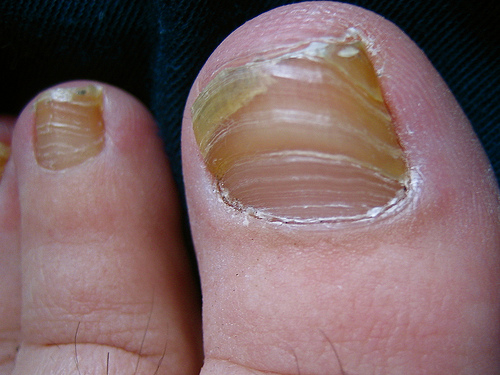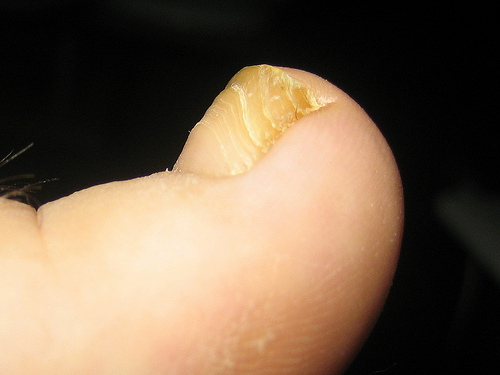
Onychomycosis is a fungal infection of the fingernails or toenails. This unwieldy medical term can be divided into onycho-, which refers to nails and –mycosis, which is a fungal infection. This condition is responsible for about one third of all fungal skin infections. Half of all diseases of the fingernails and toenails are diagnosed as onychomycosis.

Onychomycosis is generally a disease of older patients with most cases occurring in patients older than the age of 40. It is 30 times more likely for the disease to occur in adults that in children. Onychomycosis is very common and becomes more prevalent as people age. About 20 percent of all people between age 40 and 60 have onychomycosis. In fact, it has been estimated that as many as 90% of elderly patients have the disease.
Onychomycosis tends to occur more often in men than in women; however women are more likely to have an infection of a specific type of fungus called Candida. The disease occurs equally across all races.
Doctors have noticed that the number of cases of onychomycosis has been increasing over the past few decades. One major reason for this trend is that people are living longer lives. Since onychomycosis is extremely common in older people, an increasingly older population brings more cases of the illness.

As people are living longer, they are also dealing with chronic medical conditions that increase the likelihood of contracting onychomycosis. For example, diabetes is quite prevalent and we know that diabetes leads to problems with wound healing and increased susceptibility to certain infections.
Poor peripheral circulation, a problem for many people in Western countries, leads to poor wound healing, too. Poor circulation in the legs and feet is thought to provide an ideal situation for fungal infections since the immune system is less able to defend the body.
A fungal infection of the nails does not usually cause any symptoms, especially at first. By far the most common complaint from people that have onychomycosis is the way that the nail looks. The disease leaves the nail looking unappealing. Onychomycosis often disfigures the nail.

This cosmetic affect should not be dismissed—people often avoid social interactions because of the significant embarrassment and shame that a nail fungus can cause. Patients and associates may worry that the fungus is infectious or that the diseased nail means that the afflicted person is unhealthy or unclean. The psychological, emotional, and social impact can be surprisingly profound.
While the disease may start as purely cosmetic, over time onychomycosis may cause pain in the affected finger or toe. Because the nail can become thick, patients report that they cannot feel things like they normally would. In the hands, this lack of sensation leads to problems with writing and other daily activities. In the feet, people may have trouble sensing the floor which causes them to stumble or fall. This is a particular problem in patients with diabetes and peripheral vascular disease—diseases that already cause problems with the nerves of the legs.
There are four main types of onychomycosis: distal subungual onychomycosis, proximal subungual onychomycosis, white superficial onychomycosis, and candida onychomycosis. Distal subungual onychomycosis is the most common form of onychomycosis and is usually caused by a dermatophyte called Trichophyton rubrum. This dermatophyte invades the nail plate and nail bed. The term subungual means under the nail so in distal subungual onychomycosis, the infection the infection can be seen as a white-yellow growth under and on the nail, usually towards the tip. From the tip of the finger or toe, the infection can move under the nail toward the cuticle. The nail can become pitted and folded and yellow streaks can appear in the nail.
In proximal subungual onychomycosis, the onychomycosis is again under the nail, but the infection starts at the near the base of the nail at the cuticle side. The infection moves toward the tip as the nail grows. Proximal subungual onychomycosis is the least common cause of onychomycosis in healthy people though it is fairly common in patients that have immune system deficiencies. Proximal subungual onychomycosis is most often caused by Trichophyton rubrum, but can also be caused by molds and other fungi.
White superficial onychomycosis is found in only one out of ten cases of onychomycosis. This fungal infection occurs on top or in the topmost layers of the nail. As expected by the name, the lesion in this type of onychomycosis is white and forms islands on fungus on the nail. The disease can spread and cover the entire nail plate. In contrast to the other types of onychomycosis, white superficial onychomycosis is usually caused by Trichophyton mentagrophytes, another dermatophyte.

Candida onychomycosis, the fourth form, usually begins as a chronic mucocutaneous candiasis. Chronic mucocutaneous candiasis is a long-lasting yeast infection of the skin. The yeast is called Candida (usually Candida albicans). While the other infections stay primarily on or in the nail, Candida onychomycosis often causes infection of the skin around the nail, in the proximal and lateral nail folds. Several nails are affected in Candida onychomycosis and the nails can be virtually or literally destroyed by this serious fungal infection.
References
Hainer BL. Dermatophyte infections. Am Fam Physician 2003;67:101-108.
Jaffe R. Onychomycosis: recognition, diagnosis, and management. Arch Fam Med 1998;7:587-592.
Kaur R, Kashyap B, Bhalla P. Onychomycosis–epidemiology, diagnosis and management. Indian J Med Microbiol 2008;26:108-116.
Click Here For Highest Rated Nail Fungus Treatments
1. Funginix - www.Funginix.com
2. Zetaclear - www.Zetaclear.com
3. PurNail - www.Purnail.com

Julia Barry says:
i’m having trouble identifying mine.it’s yellow all over, and flaky.i think
the nail is even ready to fall off i’m afraid to touch it. it’s kind of painful
too. disregarding the kind of fungus i may have, should i try some topical
treatments already?are there ointments available over the counter?how about that
zetaclear stuff, does that work?how about fungusil? what would you recommend?
there are tons of choices over the net i’m not sure which one to trust.
Jenn says:
Hi Julia,
Mine started off with the same problem. The nail is most likely ruined, so don’t be discouraged if it does fall off. Most likely it will fall off because the new nail is trying to grow out underneath. In my experience, when the damaged nail falls off, the new nail grows in much more quickly.
Avoid the fungus killing treatments you find in drugstores. These most often treat only skin fungus around the nail, on the skin. You need something that will kill the infection in the nail itself, and under the nail bed.
I’ve had very good results with both Tea Tree oil, and Nonyx nail gel. The tea tree oil tended to turn my nails yellow, so I discontinued it altogether. Nonyx smells like vinegar, but works well. Just follow the directions on the box and your nail should grow out clear. Good luck!